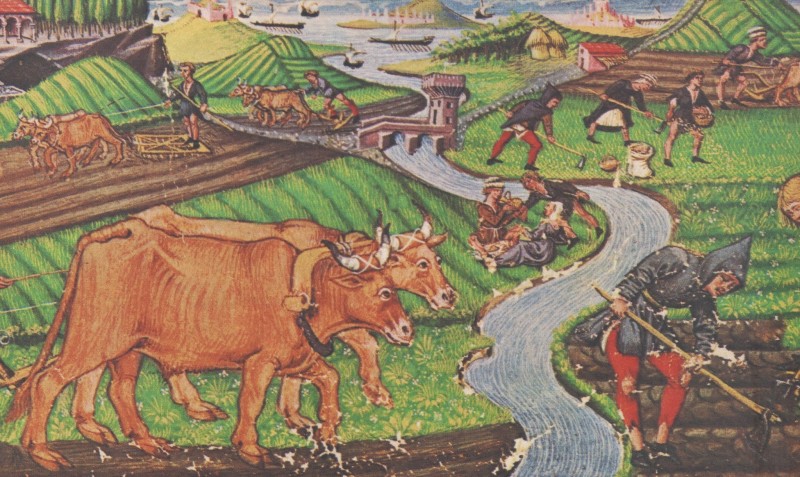Rural Life in the Middle Ages
The largest part of the land was covered with forests - a natural landscape. Humans had very simple tools to work on the land. Droughts and floods, cold and heat and specially severe winters, heavy rainstorms or bad weather could destroy a large part of the harvest. The majority of people in the Middle Ages lived as peasants in small settlements or villages.
The family community where people lived together simplified their life. Everyone helped to ensure their survival. Even the children had to work hard and cooperate in the community. In addition to the field work, the women had to look after the animals: chickens and goats. Women had to cook, wash and take care of the garden. In contrast, the men worked mostly in the field and were responsible for all the manual work and repairs. Only labour and painstaking efforts let people cultivate at least an island for agriculture and their livestock.
The houses were mostly built of wood and clay in the late Middle Ages. The foundation was built of stone. The houses were covered depending on the area with straw, reeds or shingles. The windows were small, because glass was too expensive and no room heat could be lostdue to too large window openings. The farm yard consisted of the house, the garden, and the field. The work started at sunrise.

Life was hard and particularly dependent on the weather. The destruction of a large part of the crop led to hunger as a result. So it is not surprising that people considered the harvest festivals in the annual circle as a welcome change and they were exuberantly celebrated with the obligatory church consecration.
The center of the house was the kitchen with the stove. The stove served a function of a place for cooking and a heater. The stove ensured the survival of the family. The stove was therefore fired early and it kept glowing all day long. The smoke of the fire smoked the meat hanging over the stove and conserved it. While the farmer made fire, servants and maids helped with breeding cattle, grazing the cattle and driving the cattle. There was dirt and stench on the farm. That was unavoidable. Of course, mice and rats were also part of the farm. The manure was collected carefully. It was considered a treasure, as it was the single fertilizer with which the peasants could make the soil fertile. The amount of manureraised a status. The more manure there was on the farm the more respected the farmer was. The central water supply did not exist. Peasants had go to the well or to the river.
The farmers were largely vegetarians, there was mostly cereal porridge on the table. People ate meat only on high feast days and in autumn. Then a part of the cattle was slaughtered so as not to have to bring them through the winter. The meat that could not be eaten immediately was made into sausages or smoked. People especially liked to eat pork, while chicken was a nobleman's food and was reserved to appeal to the tastes of the upper class.
Slaughtered animals’ parts: meat, skin, bristles were used thoroughly, nothing was thrown away.
Peasants drank usually water, kumiss or whey, sometimes beer.
The peasants' clothes were made of linen, flax or wool, mostly in brown or gray; colorful colors were intended for the nobility. The clothes of the farmers were very simple. They consisted of a short smock, a tunic with wide sleeves and long dresses. They were made by the women. They wore cow-leather shoes and sometimes a straw hat and/or a coat.
 uk
uk en
en



